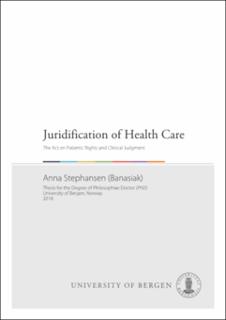| dc.description.abstract | This thesis explores how the patients’ right to information and participation (the RTIP) is interpreted by the Norwegian Directorate of Health, and how the corresponding legal regulations and clinical practice are assessed by clinical practitioners. The process of regulation through the RTIP is called juridification. Through case study research design, I explore the characteristics of written recommendatory guidelines for clinical practice and their influence on the clinicians’ assessments in the field of psychiatry. The intention of this work is to provide insights into how the regulation through the RTIP has affected the process of informing patients and involving them in treatment. I choose the institutional approach as the guiding theoretical framework for this study and assume that clinical reasoning may to some extent be the outcome of either pragmatic considerations, consequence-oriented action, or rule-following. Furthermore, using the clinicians’ subjective understandings as a starting point for the analysis, I assume that they are active, interpretative and creative actors making autonomous judgments which may not always follow the specific legislative regulations or accepted professional conventions. I define three dimensions in the context of this study - legislative, organizational and professional - focusing on their explanatory potential with regard to clinical action. The legislative dimension comprises the legislative regulations, while the organizational dimension includes the hierarchy and organization of work. The professional dimension covers clinical experience, education, professional specializations and general clinical norms. This study is based on two sources of empirical data. The first is the RTIP itself as it is described by the law, alongside its interpretations in the guidelines. The characteristics of the guidelines provide a basis for the analysis of the clinicians’ assessments, obtained from the interviews with the clinicians. These interviews are presented in the main empirical part of the thesis and constitute the second source of the empirical data. This study has shown that the combination of the three analytical dimensions mentioned above provide a more extensive, although not exhaustive, explanation of the findings than each of the dimensions separately. Certain properties of the dimensions, such as the wording of regulations, the length of experience of the practitioners, and the ways their work is organized, are analyzed in various combinations, called constellations, in the final part of the thesis in order to synthesize the findings. The constellations capture both the relatively clear tendencies in the clinicians’ assessments, as well as those outcomes of the regulations that may be seen as ambiguous or unclear. I find that juridification is a highly complex and diverse process. The guidelines are neither consequent nor in agreement with each other. These extensive variations make it reasonable to suggest that ambiguity is the main characteristic of the regulations. On one hand, this leaves much room for interpretation, which, in its turn, makes the achievement of the legislator’s goals rather challenging. On the other hand, ambiguous regulations may result in a wide range of flexible practices. Specifically, this study suggests that local practices, organization of work, and hierarchical relations influence the outcomes of regulations and clinical reasoning. Collegial decision-making seems to have a unifying effect on the team participants. The professionals who work alone seem to hold perceptions that could differ and sometimes contrast strongly with the understandings of specialists working in teams. Furthermore, the leaders’ understandings may differ significantly from non-leaders. Local practices tend to influence the clinicians’ preferences with regard to, for example, specific methods of treatment, such as medical or therapy-based procedures. These preferences seem to affect the way clinicians interpret the regulations. The differences in the profession between psychologists and psychiatrists have, on the contrary, not necessarily been shown to affect the clinicians’ assessments, for a variety of reasons. The study has also shown that the longer the experience, the stronger is the influence of clinicians’ own authority and judgment upon their practice, rather than that of the written rules and recommendations for best practice. It is reasonable to suggest that experienced practitioners can keep the large degree of their discretionary power in spite of legal changes. Furthermore, institutionalization of clinical norms in legislative regulations may to some extent contribute to the discretionary evaluations embedded in the clinical autonomy. Clinicians with little experience tend to reject traditional thinking and follow the legal goals. The case of this study shows that weak procedural rights may both enlarge and limit the patients’ possibilities to influence their treatment, depending on the clinical context. The regulations are followed differently, with some patients being allowed to decide upon their treatment while others are expected to accept the standard offer with much less possibility to participate in the choice of treatments. This work has shown that it is possible to influence clinical practice through legislative regulations. The outcomes of such influence, however, may vary and seem to differ from clear to more ambiguous ones. | en_US |
